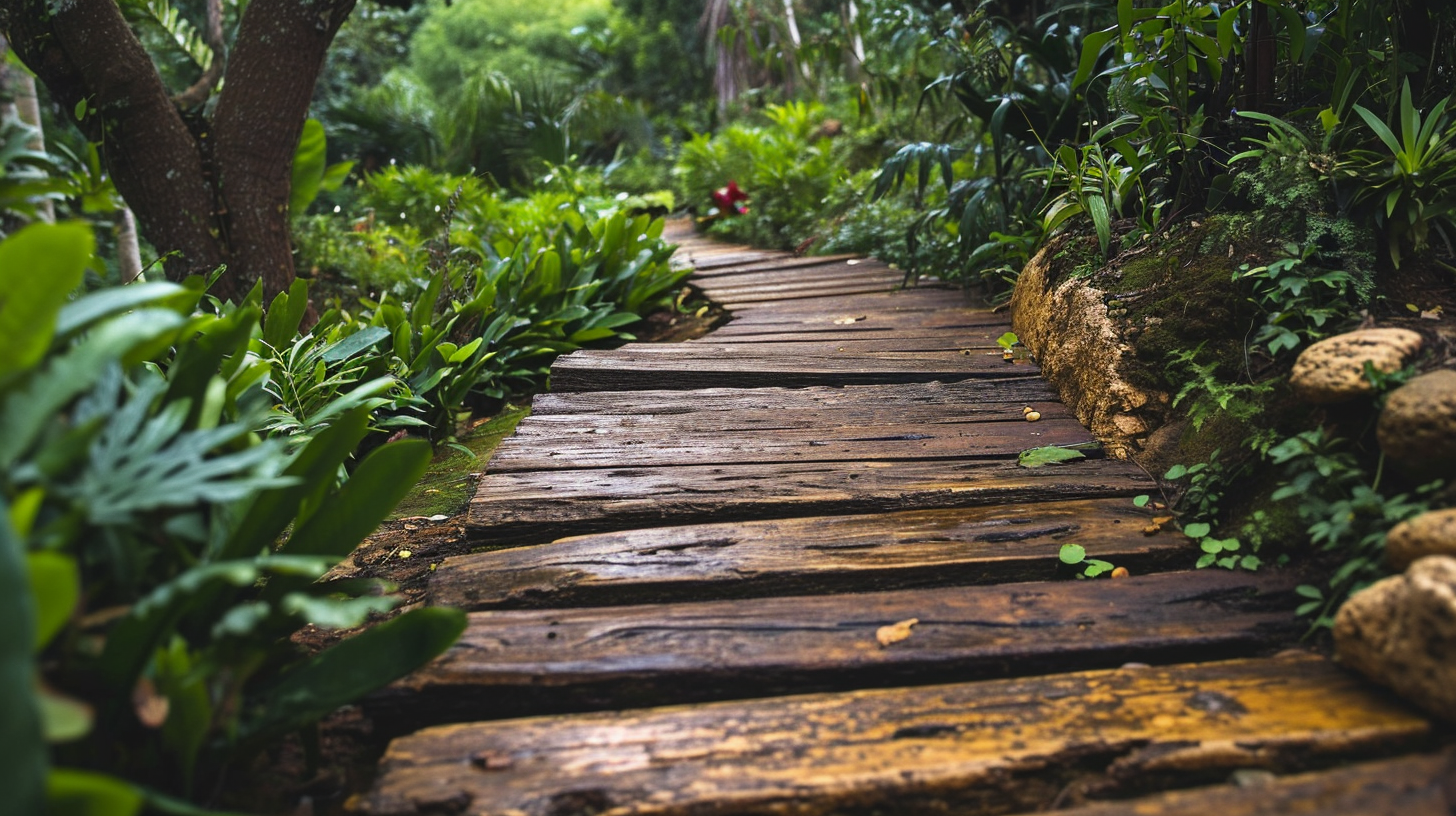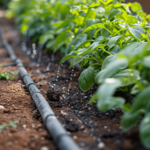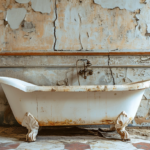Welcome to our comprehensive guide on how to install a wooden walkway. Whether you’re looking to enhance your outdoor space or create a functional path, this step-by-step article will provide you with the necessary knowledge and skills. From assessing your space and gathering the right tools to troubleshooting common issues, we’ll walk you through the entire installation process. With our professional guidance, you’ll be able to create a sturdy and visually appealing wooden walkway that will withstand the test of time.
Assessing Your Space and Determining the Best Location for Your Wooden Walkway
One important step in installing a wooden walkway is assessing your space and determining the optimal location, taking into consideration factors such as the number of obstacles and the desired length of the walkway. Evaluating the environmental impact is also crucial in this process. Before beginning the installation, it is essential to evaluate the impact the walkway may have on the surrounding environment. This can include assessing the potential disruption to plant life, wildlife habitats, or water drainage patterns. Additionally, designing a curved walkway can enhance the aesthetics and functionality of the space. A curved walkway not only adds visual interest but also allows for a more natural flow and integration with the surrounding landscape. By carefully assessing your space and considering the environmental impact, you can create a wooden walkway that enhances your property while minimizing any negative effects.
Gathering the Necessary Tools and Materials for the Installation Process
After carefully assessing your space and considering the environmental impact, the next step in installing a wooden walkway is gathering the necessary tools and materials for the installation process, ensuring that you have everything you need to complete the project efficiently and effectively. When it comes to choosing the right tools, it is important to consider the size and complexity of the project. Common tools needed for installing a wooden walkway include a shovel, a tape measure, a level, a circular saw, and a power drill. Additionally, selecting the appropriate materials is crucial for the longevity and durability of the walkway. It is recommended to use pressure-treated lumber or composite decking boards that are resistant to rot and decay. Moreover, considering the climate and weather conditions in your area will help in making the right material selection. By gathering the necessary tools and materials, you will be well-prepared to begin the installation process and create a beautiful and functional wooden walkway.
Preparing the Ground and Ensuring a Level Foundation for Your Walkway
Before beginning the installation process, it is crucial to prepare the ground and ensure a level foundation for your walkway, as this will provide stability and prevent any future issues with the structure. One important aspect of preparing the ground is establishing proper drainage. This involves evaluating the slope of the area and making any necessary adjustments to ensure water flows away from the walkway. Without proper drainage, water can accumulate and cause damage to the wooden walkway over time. Additionally, it is essential to take steps to prevent weed growth. This can be achieved by removing any existing vegetation and applying a weed barrier before laying down the walkway material. By addressing these factors during the preparation phase, you can create a sturdy and long-lasting wooden walkway that enhances the aesthetic appeal of your outdoor space.
Building a Sturdy Framework for the Wooden Walkway
When building a sturdy framework for a wooden walkway, it is important to consider the proper support structures. Using materials such as pressure-treated lumber or composite decking boards can help ensure durability and longevity. By choosing the right materials and constructing a solid framework, you can create a walkway that will withstand the test of time.
Proper Support Structures
The proper support structures for the wooden walkway are crucial to ensure its stability and durability. When installing a wooden walkway, it is important to consider the materials and costs involved in order to make an informed decision. Assessing costs is an essential step in the planning process, as it allows for budgeting and resource allocation. It is also important to explore alternative materials that may offer similar benefits at a lower cost. For example, composite materials can provide the look and feel of wood while offering increased durability and reduced maintenance requirements. By carefully assessing costs and exploring alternative materials, the proper support structures for the wooden walkway can be chosen to ensure a long-lasting and cost-effective solution.
Choosing the Right Materials
To ensure the construction of a sturdy framework for the wooden walkway, careful consideration must be given to choosing the right materials that will provide both durability and long-term support. One of the key factors to consider is the wood treatment options available. Wood treatment involves applying chemicals to the wood to enhance its resistance to decay, insects, and weathering. There are various treatment options to choose from, such as pressure-treated wood, which is infused with preservatives to protect it from rot and decay. Another option is using naturally durable wood species, like cedar or redwood, which have built-in resistance to decay. Additionally, cost considerations play a significant role in material selection. Pressure-treated wood tends to be more affordable, while naturally durable wood species can be pricier. Ultimately, the chosen material should strike a balance between durability and cost to ensure the longevity and stability of the wooden walkway.
Ensuring Long-Lasting Durability
Using pressure-treated wood or naturally durable wood species, it is essential to carefully construct a sturdy framework for the wooden walkway to ensure long-lasting durability. Proper wood treatment and weatherproofing techniques are crucial in maintaining the structural integrity and appearance of the walkway. Pressure-treated wood is a popular choice due to its resistance to decay and insect damage. It is treated with chemicals that penetrate deep into the wood, providing long-term protection against rot and decay. However, it is important to note that pressure-treated wood can still be vulnerable to weathering and UV damage. To enhance the durability of the walkway, applying a high-quality wood sealer or stain can provide an additional layer of protection against moisture, sunlight, and temperature fluctuations. Regular maintenance, including cleaning and reapplying sealant as needed, will help preserve the wood’s longevity and ensure a safe and attractive walkway for years to come.
Installing the Wooden Planks or Boards for the Walkway Surface
When installing the wooden planks or boards for the walkway surface, there are several important factors to consider. The first is plank placement and spacing, ensuring that the boards are evenly spaced and aligned for a smooth and safe walking surface. Secondly, choosing the right wood is crucial for durability and longevity, considering factors such as resistance to rot and weathering. Lastly, securing the boards properly using screws or nails will ensure stability and prevent any movement or potential hazards.
Plank Placement and Spacing
The optimal spacing between wooden planks for a walkway surface should be approximately 1 inch to ensure proper drainage and prevent water pooling. This spacing allows water to flow through the gaps, minimizing the chances of water accumulation and potential damage to the planks. Additionally, proper plank placement and spacing can contribute to the longevity and maintenance of the walkway. Regular plank maintenance is essential to keep the walkway in good condition. This includes inspecting for any signs of damage, such as cracks or rot, and addressing them promptly. Applying weatherproofing techniques, such as sealing the wood or using a weather-resistant finish, can also help protect the planks from moisture, UV rays, and other weather-related elements. These maintenance and weatherproofing practices can extend the lifespan of the wooden walkway and ensure its durability and functionality.
Choosing the Right Wood
Oak and cedar are both popular choices for wooden walkways due to their durability and natural resistance to rot and decay. When choosing the right wood for a walkway, it is important to consider wood treatment options and cost considerations. Wood treatment options such as pressure-treated lumber or wood preservatives can enhance the longevity and resilience of the walkway. Pressure-treated lumber is a common choice as it is infused with chemicals that protect against rot, insects, and decay. However, it is important to note that these chemicals may leach into the soil over time. Alternatively, cedar is a natural choice that offers similar benefits without the need for chemical treatment. Cost considerations should also be taken into account, as cedar tends to be more expensive than oak. Ultimately, the choice of wood for a walkway should be based on a balance between durability, natural resistance, treatment options, and cost.
Securing the Boards
To ensure stability and prevent shifting, proper fastening techniques, such as using galvanized screws or nails, are essential for securing the boards in place for the wooden walkway surface. When installing a wooden walkway, it is important to choose the appropriate securing techniques to ensure its longevity and safety. Galvanized screws or nails are recommended as they are resistant to rust and corrosion, which can weaken the fasteners over time. Additionally, it is important to regularly inspect the walkway for any loose or damaged boards and promptly replace or repair them. Regular maintenance tips include cleaning the walkway with a mild detergent and water solution and applying a protective sealant to prevent moisture damage and prolong the lifespan of the wood. By following these securing techniques and maintenance tips, you can enjoy a durable and safe wooden walkway for years to come.
Securing the Wooden Walkway to Ensure Stability and Longevity
Ensuring the stability and longevity of the wooden walkway requires implementing proper anchoring techniques. Securing joints and preventing rot are two key considerations when it comes to anchoring a wooden walkway. When securing joints, it is important to use strong connectors such as screws or nails, ensuring they are driven deep into the wood to create a solid connection. Additionally, using adhesive or wood glue can further strengthen the joints. To prevent rot, it is crucial to treat the wood with a water-resistant sealant or preservative. This will protect the wood from moisture and fungal growth, extending its lifespan. Regular maintenance, such as cleaning and reapplying sealant, is also necessary to prevent rot. By properly securing joints and preventing rot, the wooden walkway will remain stable and durable for years to come.
Adding Finishing Touches and Enhancements to Your Wooden Walkway
By incorporating decorative elements and considering safety features, one can personalize and elevate the aesthetic appeal of their wooden walkway. Enhancing the aesthetics of a wooden walkway can be achieved through various methods. One way is to add decorative elements such as potted plants or flower beds along the sides of the walkway. This not only adds visual interest but also brings a touch of nature to the space. Another way to enhance the aesthetics is by adding lighting. Installing solar-powered lights along the path can create a warm and inviting atmosphere, especially during the evening hours. Additionally, incorporating safety features such as handrails can not only provide support but also add a visually appealing element to the walkway. By considering these enhancements, one can transform their wooden walkway into a beautiful and functional outdoor feature.
Maintaining and Preserving Your Wooden Walkway for Long-Term Use
When it comes to maintaining and preserving your wooden walkway for long-term use, regular cleaning and applying a protective sealant are essential steps in ensuring its durability and longevity. Preserving techniques and weatherproofing methods are crucial in protecting the wood from the damaging effects of the elements. Regular cleaning involves removing dirt, debris, and stains that can degrade the wood’s surface over time. This can be done by sweeping or using a pressure washer with a gentle setting. After cleaning, it is important to apply a protective sealant to shield the wood from moisture, UV rays, and other environmental factors. There are various types of sealants available, including oils, stains, and clear finishes, each offering different levels of protection and aesthetic options. It is recommended to consult with a professional or research the best sealant for your specific wooden walkway to ensure proper preservation and long-term use.
Troubleshooting Common Issues and Finding Solutions for Your Wooden Walkway Installation
To effectively troubleshoot common issues during your wooden walkway installation, consider implementing a step-by-step approach and consulting a professional for guidance. One of the most common installation problems is wood rot, which can compromise the structural integrity of your walkway. To prevent wood rot, it is important to ensure proper drainage by installing a gravel base and using pressure-treated lumber that is resistant to moisture. Additionally, sealing the wood with a waterproofing product can provide an extra layer of protection against rot. Other installation problems that may arise include uneven boards, loose screws, and gaps between the boards. These issues can be addressed by carefully measuring and leveling the boards before installation, using appropriate fasteners, and filling any gaps with wood filler or caulk. By following these troubleshooting techniques, you can ensure a successful and long-lasting wooden walkway installation.




